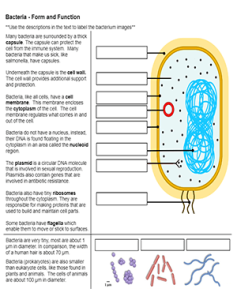
Bacteria are tiny single-celled organisms that are all around us, too small to be seen without a microscope. They’re living things that come in different shapes like spheres (called cocci), rods (called bacilli), or spirals. Some of them are helpful, like the ones that help us digest food, while others can make us sick.
In Miller and Levine’s Biology (Bee) book. Prokaryotes, like bacteria are summarized in Chapter 8. Students learn the difference between prokaryote and eukaryote cells. They learn the basic parts of all cells: membrane, DNA, cytoplasm. You can copy and edit my Google Slides for Chapter 8.
Chapter 21 covers bacteria with more details, including the topic with viruses, protists, and fungi. My students have spent much of their academic life in the shadow of covid. I think it’s important to cover vaccines and viruses at some point
As part of the cell unit, students color a plant cell and an animal cell. I also have a bacteria cell coloring, but with my freshman honors class, this gets to be a little too much coloring. Instead, they read about bacteria form and function and label a diagram. I modified a bacteria cell from Wikimedia to include all of the major parts for students to label. For fun, I have a collection of giant microbes where I can show students was some of the common pathogens look like. My favorite is E. coli!
The activity also includes a comparison between the different types (shapes) of bacteria. From descriptions, students label each bacteria and compare the size of bacteria to the width of human hair. Unfortunately, I do not recommend using bacteria for microscope activities. Beginning biology students struggle with microscopes even when examining large cells in plants. Bacteria cells are very tiny!
Students then complete a short question set that can be answered from the text. I also included a maze just for fun!

